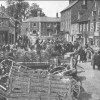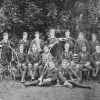Regular users of the A350 between Blandford and Shaftesbury are routinely confounded and irritated by a series of hazardous left and right hand bends just north of Stourpaine and someway south of Iwerne Minster. Such bends often arise when the course of a road has been determined by the furlongs and headlands of medieval open-field systems. But the Stourpaine – Iwerne bends are considerably more recent being part of a landscaping re-organisation around an estate owned by one of Dorset’s more flamboyant Hanoverian country squires – Peter Beckford.
Beckford was born in 1740 into an aristocratic family who had made their fortune from the ownership of sugar plantations in Jamaica. His father was Julines Beckford and his mother Elizabeth Ashley, was the daughter of the MP for Bridport. Julines elder brother, known as ‘Alderman’ Beckford was a highly influential figure in Parliament and in the City, reputed to be at the time the wealthiest commoner in England.
Peter spent his later childhood at Steepleton, a house and estate now lying in the loop formed by the road-bends near Stourpaine. Julines Beckford had bought the mansion in 1745 when he became attracted to the brick stables and kennels already on the estate. Steepleton was then still a modest residence but later Julines bought the adjoining estates of Durweston and Shillingstone. This suited Peter’s father, as he was a keen huntsman, but he also indulged a passion for sports, languages, art and music, interests his son inherited. He further added another wing to each end of the house in about 1758.
As a young man Peter Beckford went on a grand tour of Europe and spent a number of years in Italy when he was portrayed with one of his dogs by the painter Batoni and met Muzio Clementi, a musical prodigy who Beckford brought back to live with him at Steepleton. Clementi remained in Dorset for the next seven years before moving to live and work in London.
Beckford was also interested in political economy and Government, being elected MP for Morpeth in 1767 but as he was not of the temperament to apply himself to political duties he later stood down from the seat. In 1773 he married Louisa, the nineteen-year-old daughter of George Pitt of Strathfield Saye (later the 1st Baron Rivers,) but the union was beset with some unhappiness. For a while the couple lived in London, but Beckford’s dislike of the high society of the capital compelled him to return to Stepleton. At heart it was in the role of country squire that he was most content. The Beckford’s first three children died in infancy, but eventually the couple had two surviving children: a son William Horace and a daughter, Harriet.
The incidence of the road re-organisation came about when the landowners of the estates adjoining Steepleton wanted to build a straight and wider road but on a course that would take it across part of the Stepleton estate. They therefore sent their surveyors to Beckford to explain the plan and hoped that he would approve the work, but the Squire of Stepleton was secretly adamant that he would not do so. In a display of insincere hospitality he caused the surveyors to forget the purpose of their visit by entertaining and mildly intoxicating them with glass after glass of spirits. Eventually the surveyors were left with no option but to re-route or improve the road around Steepleton’s tortuous boundary.
Like most of his family Beckford never visited the plantations he inherited in Jamaica, and so had no idea how the life of the slave-labourers contrasted with the cosy, privileged existence of an English country squire. His cousin William had taken the artist George Robertson out to Jamaica in 1774 where he painted a number of landscapes intended to portray the lush vegetation of the island, but which did not give any hint of the poverty and hardships of the slave underclass who worked themselves into early graves to create wealth for their master in England.
However, Beckford’s time abroad as an absentee landlord of extravagant spending beyond his means had led to his estates in England and Jamaica becoming run down and unprofitable. The income from the Jamaica plantations had been falling since the 1770’s as the land became exhausted and the price of slaves and stores increased. For example a Negro slave who cost £25 in 1755 cost £60 by 1770, and the government had increased the import duty on sugar. A series of five devastating hurricanes between 1780 and 1786 compounded the slump. The value of the estates plummeted, and absentee proprietors like Beckford were at the mercy of unscrupulous managers.
To ameliorate growing insolvency Beckford sold the Durweston part of his estates to Henry Portman of Bryanston in 1774, and was forced to mortgage two of the plantations to Baron Rivers for £4,000 in 1778. Hope for the Beckford fortune lay in William Horace’s being able to inherit the Pitt estates one day when Louisa’s brother George – a bachelor unlikely to marry died. But Horace had inherited much of Louisa’s immature and unstable mentality. Beckford’s heir became a profligate gambler who ran up great debts unknown to his father, and eventually had to appeal to his uncle George for £12,000 secured on Peter’s Dorset properties in order to bail him out.
Meantime, out of boredom Louisa was diverted into an affair with William Beckford, the future builder of Fonthill Abbey, though Peter chose to ignore the adulterous relationship. After becoming totally estranged from her husband Louisa went to live in Bath. His wife away, Peter spent his time hunting and building up a pack of hounds (of which he knew each by name.) He commissioned the painter Francis Sartorious, who specialised in animal studies, to portray himself on horseback, with his dogs around him. Beckford also, between 1779 and 1781, wrote a book in the form of a series of letters to a friend called ‘Thoughts on Hunting,’ a treatise that became a best seller.
In 1783 Beckford learnt that Louisa had contracted tuberculosis, and in the hope that a warmer climate might restore her health, he took her to Italy. Louisa however, succumbed and died of the disease in Florence in 1791. She was buried in the English cemetery at Leghorn. But Beckford remained abroad in Italy until forced to return to Stepleton for good when the French under Napoleon invaded northern Italy in 1799, although he returned to Stepleton for short visits a number of times in the proceeding years. His son Horace by then 22, and daughter Harriet returned with him.
Peter Beckford died a sad old man, burdened with worry and debts, at the age of 69 in 1809 and was buried in the church at Steepleton. Though he was a man of many talents, they did not bring him happiness. He lies beneath a tomb with a square entablature bearing the Latin inscription ‘PB Sibi et Suis MDCCCIX’ (Peter Beckford; To Him and To His; 1809.)
William Horace inherited the Pitt estates in 1828, and in accordance with his father’s will assumed the name Pitt-Rivers, becoming the 3rd Baron Rivers. The inheritance however, proved to be debt-ridden, and he drowned himself in the Serpentine, Hyde Park, in 1831. Stepleton remained part of the Pitt estate until 1919, when it was bought by Sir Ranulf Baker of Ranston; he later sold off the house and park.



